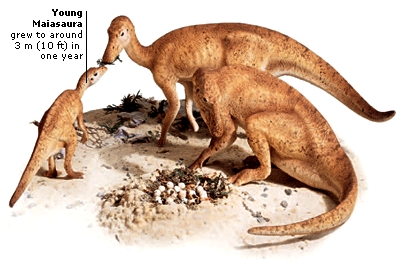DK Science: Nesting Colonies
Ever since dinosaurs were identified as reptiles, scientists have assumed that they laid eggs, in the same way that most modern reptiles lay eggs. This was confirmed when the first dinosaur eggs and nests were found in the Gobi Desert, Mongolia, in the 1920s. Since then many more finds have been made – most importantly the discovery of a nesting colony of Maiasaura in Montana, USA. Many nesting sites show evidence of bird-like behaviour that adds weight to the theory of some scientists that birds evolved from feathered dinosaurs.
In the 1970s, at a place named Egg Mountain in Montana, USA, a whole colony of fossilized hadrosaur nests was found. They belonged to a dinosaur called Maiasaura. The nests had been made of mud, and were about 1 m (3 ft) high, with a bowl-like depression in the top. It is thought that migrating herds of Maiasaura returned to this mass breeding ground year after year to lay their eggs and raise their young.
There were many different fossils at the Montana site. Egg shells in the nest showed where the eggs had hatched. The bones of hatchlings revealed that some of the babies did not survive the first few days. The bones of older youngsters showed that the young remained at the nesting site for a long time before becoming independent. It seems the parents looked after them in the same way as birds care for their young, feeding and caring for them until they are ready to leave.
The nests at the Egg Mountain site were evenly spaced. The distance between each nest was roughly the length of an adult Maiasaura. Large groups, or colonies, of Maiasaura probably nested together to protect themselves from attack. Although this site is called Egg Mountain, it was not mountainous during the Late Cretaceous Period. At that time it lay on a beach by the side of a big freshwater lake.
In the 1920s the dinosaur eggs discovered in the Gobi Desert, Mongolia, were first believed to be the eggs of the horned dinosaur Protoceratops. Near one nest lay the fossil skeleton of the small theropod Oviraptor, and everybody assumed it had been killed while robbing the Protoceratops’ nest – Oviraptor means “egg thief”. It was not until the 1990s that scientists discovered that in fact the eggs belonged to the Oviraptor.
An Oviraptor fossil was found on an expedition to the Gobi Desert in 1993, and it revealed the true nature of the first Gobi Desert eggs. The Oviraptor’s skeleton lies over the eggs, its arms spread out to cover them, in the same way a bird protects its clutch of eggs. Feathers on the arms would protect the eggs from the sun during the day, and keep them warm at night. The dinosaur probably died protecting the eggs from a sandstorm or flood.
To order this book direct from the publisher, visit DK's website.


